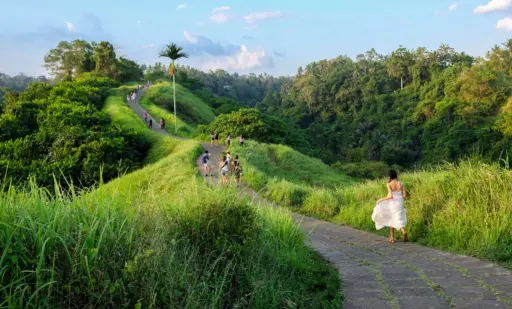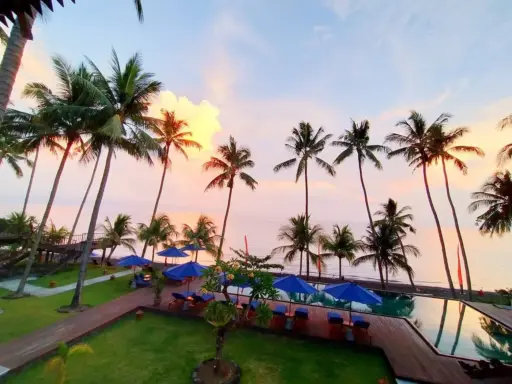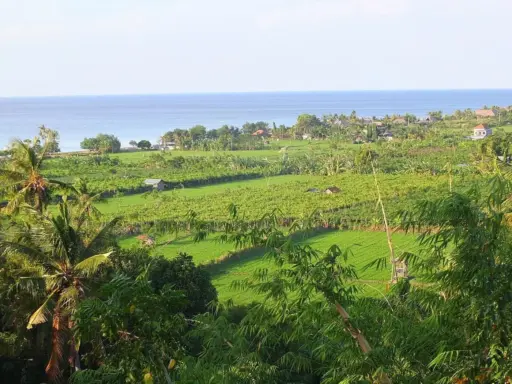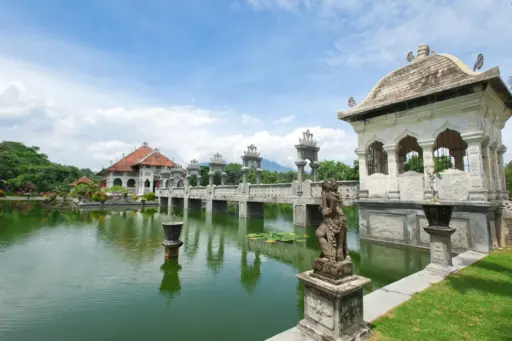Tucked into the lush hills of central Bali, Ubud moves to a different rhythm. While beach towns like Seminyak and Canggu throb with energy and oceanfront glamour, Ubud hums gently with creativity, spirituality and connection to nature. It is not just a place on the map – it is a state of mind. For many travellers, Ubud represents the heart of Bali, both geographically and culturally. It offers a slower, more reflective experience of the island, yet it is anything but boring.
A Brief History: From Royal Retreat to Global Magnet
Ubud’s story begins in the 8th century, when a Javanese priest named Rsi Markandeya is said to have meditated at the confluence of two rivers in what is now Campuhan, just outside the modern town. He established a temple there – Pura Gunung Lebah – which remains one of the area’s most important spiritual sites. Over time, the area grew as a spiritual centre, with Hindu temples and royal compounds forming the foundation of Ubud’s identity.
The name “Ubud” comes from “ubad”, the Balinese word for medicine, which reflects the healing properties of the jungle plants and the area’s reputation as a centre for natural medicine and traditional healing. Healers (balian) and priests have lived and practiced here for centuries, giving the town an enduring spiritual pull.
Ubud’s artistic rise began in earnest during the early 20th century. In the 1930s, German painter Walter Spies and Dutch artist Rudolf Bonnet moved to Ubud and became central figures in the development of modern Balinese art. Working closely with local artists, they helped establish the Pita Maha collective, which encouraged traditional artisans to experiment with new styles while preserving their cultural roots.
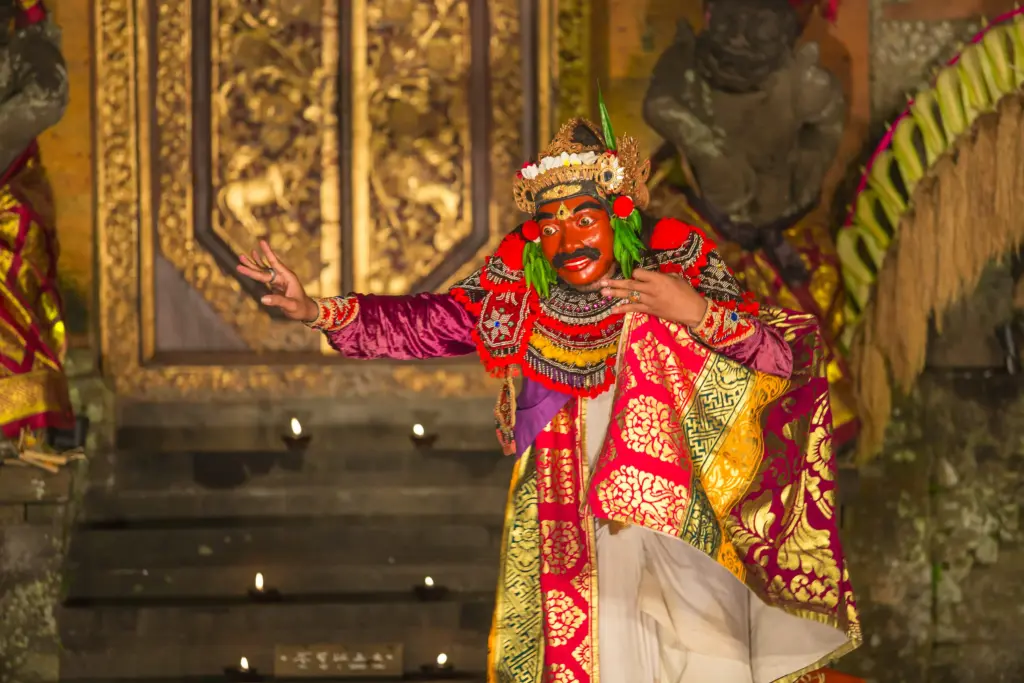
Crucially, Ubud’s royal family – especially Tjokorda Gde Agung Sukawati – supported these artistic and cultural exchanges. Their patronage ensured that the town became both a sanctuary for tradition and a hub for innovation. This open, collaborative spirit continues today, as Ubud remains a magnet for artists, thinkers, and travellers drawn to its unique blend of heritage and creativity.
The Soul of Ubud: Art, Culture and Ceremony
Ubud is often described as Bali’s cultural capital – and with good reason. Almost every village in the region is known for a specific craft, whether it is wood carving in Mas, silverwork in Celuk, or painting in Penestanan. Walking through the Ubud Art Market or visiting one of the many galleries (like Neka Art Museum or Agung Rai Museum of Art), you will see how art is not a hobby here – it is a living tradition.
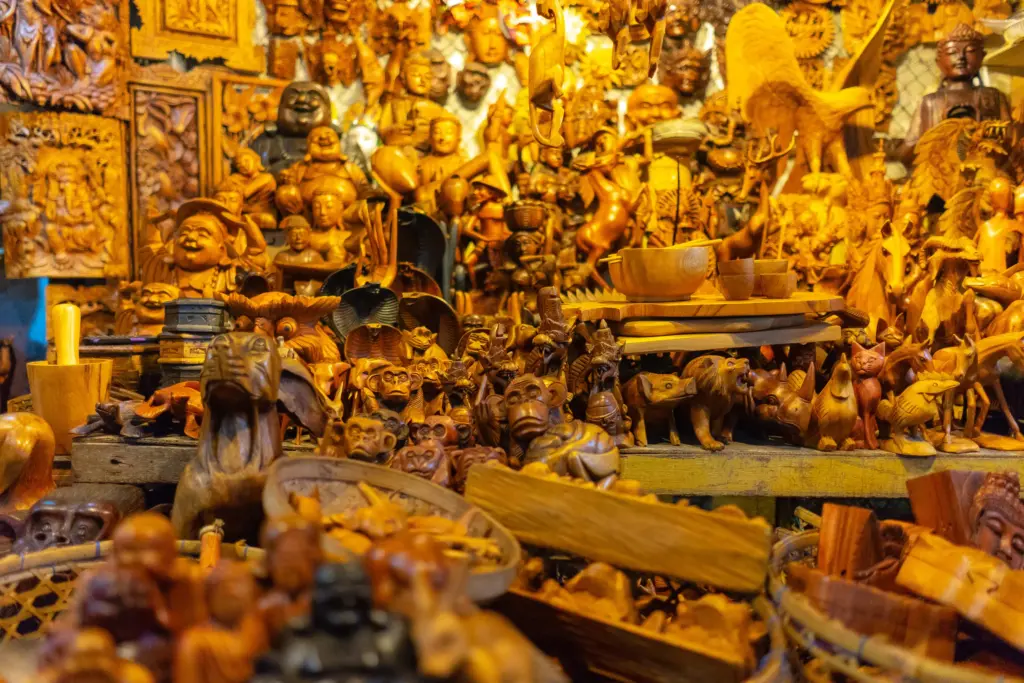
Dance and music also thrive in Ubud. Nightly performances of traditional Legong, Barong or Kecak dances take place in temples and cultural centres, often accompanied by hypnotic gamelan orchestras. These are not staged tourist shows, but genuine expressions of ritual and heritage.
Ubud’s cultural depth is also visible in its daily ceremonies. Small woven offerings (canang sari) are placed on doorsteps, dashboards and sidewalks every morning, and temple festivals bring streets to life with colour, processions and gamelan music. For visitors, witnessing these moments offers a window into the spiritual fabric of Balinese life.
Nature All Around: The Landscape of Ubud
One of Ubud’s strongest drawcards is its natural setting. Surrounded by rice terraces, rainforest and river valleys, it feels far removed from Bali’s more developed southern coast. Even from the centre of town, you are only minutes away from jungle trails, waterfalls or a quiet stroll through the paddies.
Tegallalang Rice Terraces are among the most iconic sights in Bali, located about 20 minutes north of Ubud. These sculpted landscapes are best visited early in the morning before the crowds arrive. While popular, they still offer pockets of calm, especially if you wander off the main paths.
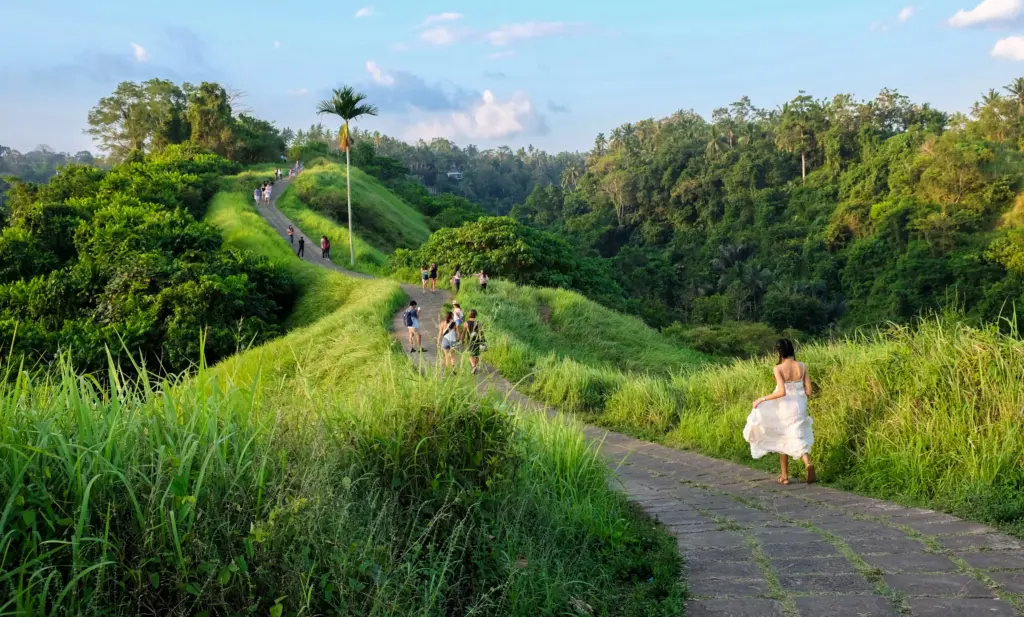
Another popular walk is the Campuhan Ridge Walk, which begins just west of the town centre. The trail leads along a narrow ridge flanked by tall grasses and views of distant volcanoes, especially beautiful at sunrise or late afternoon.
Just beyond town are Tegenungan Waterfall, Tibumana Waterfall, and the lush Ayung River valley, which is popular for white water rafting and eco-lodges.
Ubud Town: Calm, but Not Low-key
Despite its peaceful reputation, Ubud is no longer a sleepy village. The town centre can get congested, especially around Monkey Forest Road and the main market. However, there are plenty of tucked-away corners and side streets where you can still feel the calm pulse of the town.
The Sacred Monkey Forest Sanctuary, located at the southern edge of Ubud, is one of its most visited sites. It is a small rainforest filled with moss-covered statues, Hindu temples, and hundreds of long-tailed macaques. Some are cheeky and not shy about snatching a snack or sunglasses, so keep your distance and hold your belongings tight.
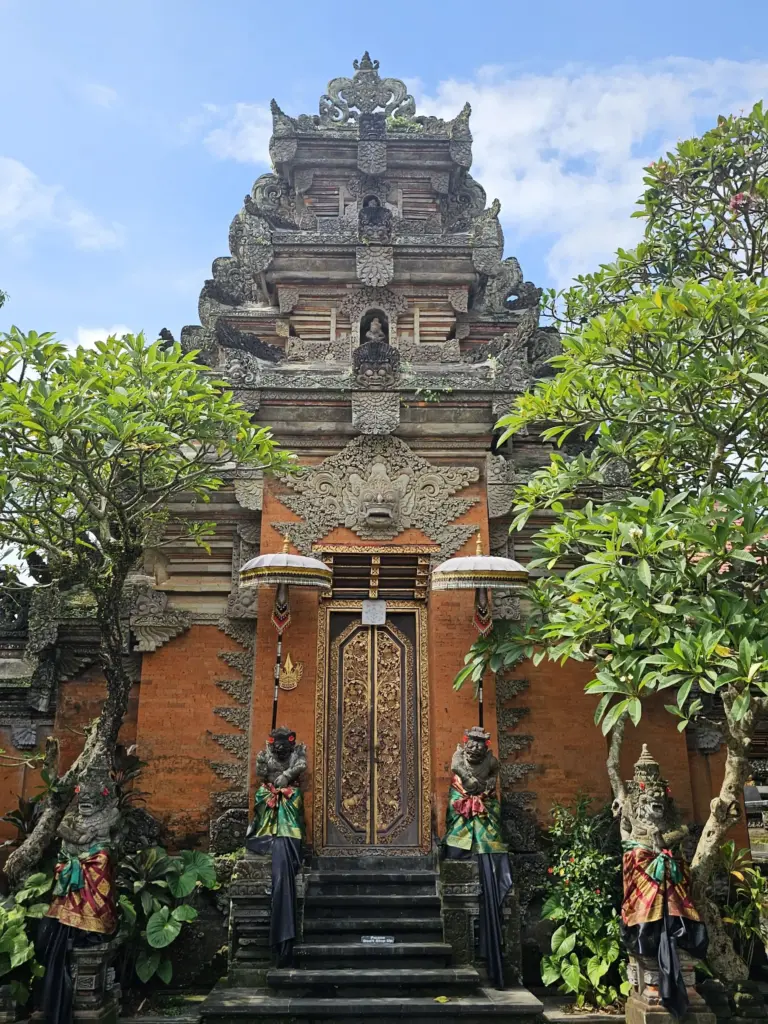
Beyond the forest, Ubud has countless independent cafes, yoga studios, and craft shops. It has a strong wellness scene, with world-class spas, holistic practitioners and a wide range of yoga and meditation classes. Studios like The Yoga Barn or Radiantly Alive draw practitioners from all over the world.
A Food Scene for Everyone
Ubud’s dining scene has evolved in recent years, now blending health-conscious cuisine with traditional Balinese food and international fare. You can eat raw vegan zucchini noodles one moment and slow-roasted suckling pig the next.
For Balinese flavours, try Ibu Oka’s Babi Guling, a long-standing institution famous for its crispy roast pork served with rice and spicy vegetables. For something plant-based, Alchemy is a pioneer of raw vegan cuisine, with a build-your-own salad bar and fresh juices.
Other favourites include Hujan Locale (modern Indonesian), Locavore (fine dining with a local twist), and Warung Biah Biah (affordable and authentic Balinese small plates). Many restaurants also feature views over rice fields, rivers or jungle valleys, adding to the sense of peace and space.
Staying in Ubud: From Jungle Villas to Boutique Stays
Accommodation in Ubud ranges from family-run homestays to luxurious private villas tucked into the forest. What sets Ubud apart is that even mid-range places often offer beautiful natural surroundings, open-air bathrooms, and traditional Balinese design.
For something stylish yet affordable, try Taman Indrakila, Adiwana Bisma, or Sri Ratih Cottages. Travellers looking for luxury can look into Chapung Sebali, Mandapa by Ritz-Carlton, or The Kayon Jungle Resort, which offer infinity pools perched above valleys and tailored wellness experiences.
Many visitors choose to stay slightly outside the main town – areas like Penestanan, Sayan, Tegallalang, or Nyuh Kuning – to enjoy more peace and better views.
What Makes Ubud Special?
There is a reason Ubud has become a retreat for artists, writers, healers and travellers seeking something more than a beach holiday. It is the kind of place that encourages you to slow down and take stock. The pace is different here. Time stretches out between temple bells and roosters, morning yoga and evening dance.
Part of Ubud’s appeal is its contradictions. It is a small town but feels expansive. It is steeped in tradition but open to new ideas. It attracts tourists but manages to stay grounded. Unlike other parts of Bali that bend to fit visitor expectations, Ubud asks you to meet it on its own terms.
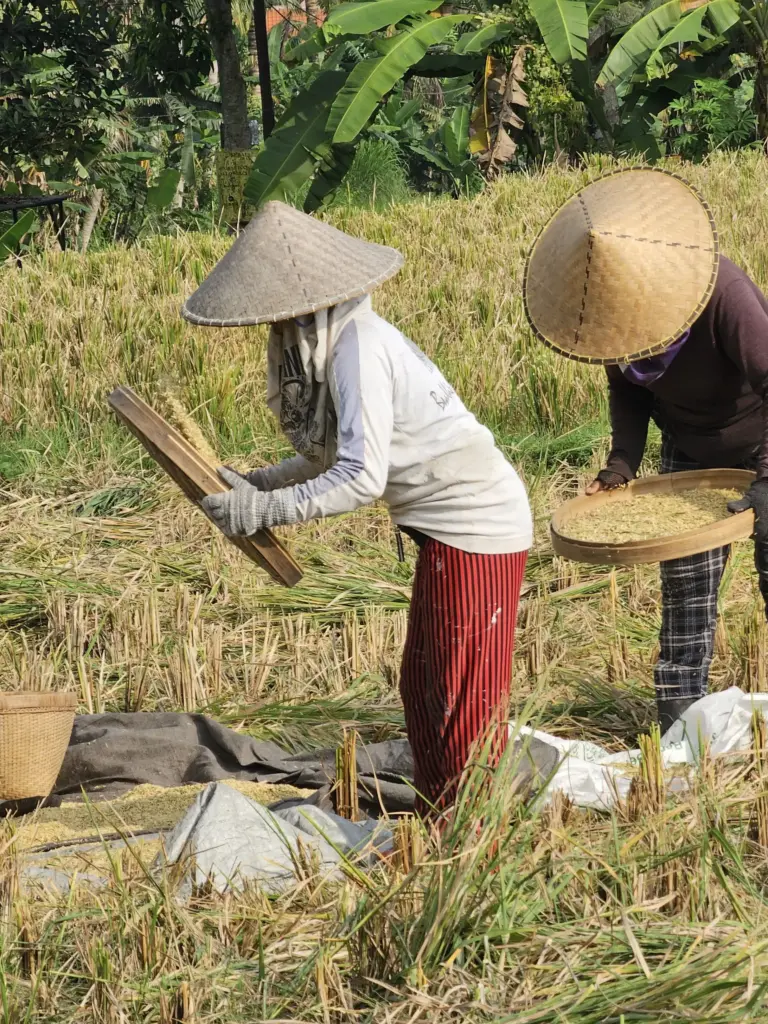
It is not just what you do in Ubud that matters – it is how you feel while you are here.
Tips for Visiting Ubud
· Transport: Ubud does not have public transport. Most visitors get around on foot, by motorbike or with a private driver. Roads can be narrow and busy, so allow extra time to get around.
· When to Go: The dry season (May to September) offers the best weather, but the green season (October to April) is quieter and more lush. Ubud is cooler than the coast, especially in the early mornings and evenings.
· Respect the Culture: Ubud is a spiritual and traditional place. Dress modestly when visiting temples, do not interrupt ceremonies, and always ask before taking photos of locals.
· Money and Connectivity: Most places accept cards, but cash is still useful, especially at markets or warungs. Wi-Fi is widely available, though rural areas may have patchy coverage.
Final Thoughts
Ubud is not the place for wild nightlife or all-day beach lounging. It is a place for early mornings, open hearts and slow travel. Whether you come to find your centre on a yoga mat, explore centuries-old temples, eat nourishing food or simply wander through a sea of green, Ubud offers a type of richness that stays with you.
You may come for a few days and find yourself staying longer. That is the quiet magic of Ubud – it does not shout for your attention, but it captures your spirit all the same.
Ubud invites you not just to see Bali, but to feel it. And once you do, it is hard to let go. Wander Beyond Ordinary!
To find out more about Ubud, please check out the Ubud Travel Guide here. (insert hyperlink to the Ubud Travel Guide)
